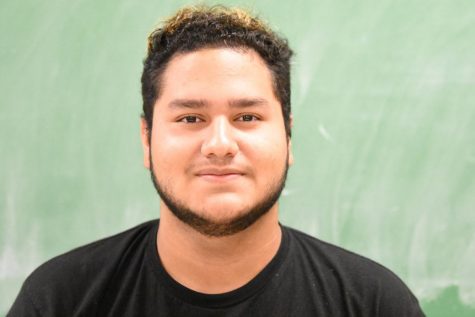Smoking policy ignored
Smoke-filled pathways, bathrooms drive complaints about smokers
CCC student Daniele Tabor smoking next to her car parked on Campus Drive on Oct. 4
Oct 9, 2019
The California Community College Board of Governors passed a resolution to make all 114 community college campuses in California 100 percent smoke-free in May of 2018.
This includes Contra Costa College.
As of Sept. 13 2017, by way of Governing Board Policy 2045, smoking on campus is punishable by a fine of up to $100.
The BOG resolution says tobacco smoke outside of campus buildings can be drawn in through ventilation intakes and/or open doors and windows. It also says students, staff, faculty and guests should be able to walk through campus and enter their respective buildings free of exposure to tobacco smoke.
According to Police Services Lt. Tom Holt, nobody is allowed to smoke on district property.
“We have to follow the same policies that we follow in the city (San Pablo),” he said. “The policy is not enforced on Mills Drive (in Richmond) but it is on Campus Drive.”
According to the California Youth Advocacy Network, over half of the state’s colleges and universities have outright banned smoking in all areas.
Recently, district Police Services has received many complaints about people not respecting the no smoking policy at Contra Costa College
Holt sent an email on Sept. 30 about students ignoring smoking-free zones around campus and lighting up.
The second-hand smoke has caused many students to feel uncomfortable while walking around campus or going into a rest room, a place where most students go to smoke or vape in an attempt to avoid being seen by other students or even the police on campus.
According to the Centers for Disease Control, tobacco smoke contains more than 7,000 chemicals, including hundreds that are toxic, and about 70 that can cause cancer. Its data also shows there is no risk-free level of second-hand smoke exposure. Even brief exposure can be harmful to health.
Most alarmingly, since 1964, approximately 2.5 million nonsmokers have died from health problems caused by exposure to second-hand smoke.
In his email, Holt encouraged people to go off campus or to designated areas if they choose to use tobacco or similar products.
“Please find an off district location to use tobacco products,” Holt wrote in his email.
Many students feel overwhelmed about people smoking on campus and some of them even had to put out signs in dining areas for people to be conscious that smoking is totally prohibited on campus.
Even though many students are working hard to keep a environment, some smokers find their way around rules by hiding in parking lots or on the wooded trails connecting buildings on campus.
Political science major Alfredo Angulo said, “Students need to respect others’ privacy and personal space and they also need to be aware that pregnant women, people with asthma and with many other disabilities are taking classes (at CCC).”
Biotechnology major Daniele Tabor takes a more responsible approach to lighting up.
“I smoke,” Tabor said, “but I’m aware that most people around me might not. So that’s why I leave campus whenever I want to smoke.”
She said people who do not follow the smoking-free policy are childish and think about themselves and not the people affected by their second-hand smoke. They deserve to be fined for disrespecting others personal space.
Students are not the only culprits who skirt the rules regarding on-campus tobacco use.
When taking a walk around campus, it is common-place to see professors leaning on fences along the CCC property line grabbing a quick smoke completely confident their smoke will find its way over the fence and away from campus.
Still, when one takes a stroll on campus, the number of students who smoke far outpaces instructors who find quiet corners of campus to calm their nerves with a cigarette.
The National Institute of Health conducted a survey of 4,100 college students to track the behavior of smokers. In the survey, 29 percent reported they are current smokers and of those, 70 percent were non-daily smokers.
The data also showed, compared to daily smokers, non-daily smokers were younger, African American (compared to whites), and had mothers with higher education.
Infrequent smoking (smoking on some, but not all days) is particularly common among college students and accounts for more than two-thirds of college smokers.



